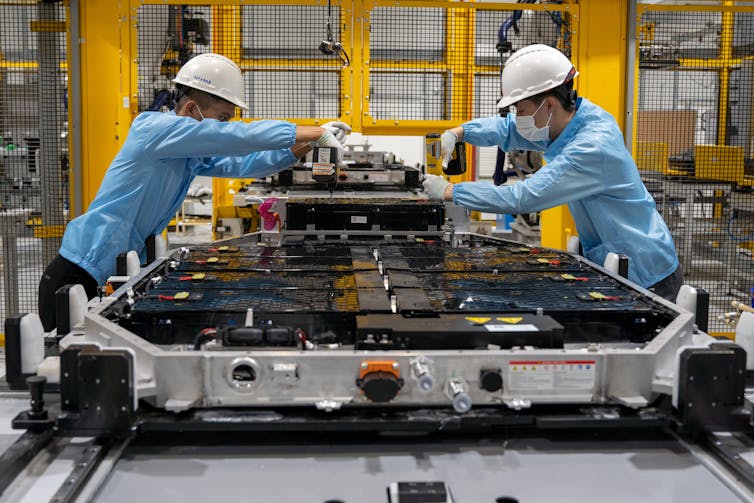The UK has delayed its ban on the sale of new cars which burn petrol or diesel in internal combustion engines (ICE) from 2030 to 2035.
In some ways, this is no surprise: the original plan was to ban them from 2040, a deadline brought forward by the previous prime minister, Boris Johnson, in 2020. The new delay, confirmed this week by Rishi Sunak, had been rumoured in August.
But the decision still sends a confusing message from Sunak’s government, particularly for carmakers who on average take six-to-seven years to develop new vehicles, and need time to invest in new factories and train workers, as well as make the cars themselves.
For these manufacturers, certainty is key to their business. If they gear up to produce an all-electric fleet and suddenly buyers still want ICE vehicles and they haven’t produced enough, they will have stockpiles of unwanted cars which may have to be sold at a loss.
However, the good news is the switch to electric vehicles (EVs) is already well under way in the UK. Research suggests it may now be unstoppable – regardless of what the government does.
How new technologies replace old ones
Any new technology follows a cycle of adoption that is difficult for government intervention to interrupt. The exception is for fast-acting bans, which attempt to immediately remove products deemed dangerous or harmful from a market. A successful example is the UK’s ban on highly realistic imitation firearms.
Grants or other incentives to buy new technologies are somewhat effective at increasing their adoption at first, but these incentives are generally withdrawn once the product is established in a market.
The rate at which new technologies are adopted can usually be mapped on to fairly predictable trajectories. American sociologist Everett Rogers plotted it on an S-shaped curve he called the diffusion of innovations. We can see that this shape holds true for smartphones.
A look at the adoption of EVs over time reveals the UK is in a rapid ramping-up phase that will naturally deliver an almost complete switch to EVs for every new car purchase by the 2030s, regardless of legislation. Already, we have gone from EVs having a less than 0.5% market share in 2016 to over 20% in 2023. This trend mirrors that of smartphones, which went from a few million when the iPhone was released to almost complete market penetration in under a decade – and all without a ban on non-smartphones.
Phones and cars aren’t a perfect comparison – generally, cars have a longer lifecycle. But the similar pattern in sales growth should still hold true once there is enough data on the EV curve. In fact, there’s a credible risk that ICE motorists will soon face the same problem EV drivers have had in recent years: difficulty refuelling.
While many drivers cite a lack of chargers as a barrier to buying an EV, as ICE car ownership drops the number of petrol filling stations will drop too. In fact, data suggests their numbers are already declining in the UK.
Another reason the UK ban will not slow the adoption of EVs is the fact it is only a part (albeit a significant one) of the wider European market that generally buys the same specification of vehicle (as opposed to other markets which have differing tastes and products). Most manufacturers will be developing their EVs to meet the whole market’s needs, and many of the countries in that market, such as Ireland, Iceland, Sweden and the Netherlands, are sticking to 2030. Norway has picked 2025 as its deadline.
If you are a car manufacturer working to a bloc sales model that averages around 2030 (remember, they have been planning on 2030 for the UK too), then you are not going to put resources into producing more of a technology that is being phased out and cannot be sold throughout most of that bloc.
NamLong Nguyen/Shutterstock
Will this affect buyer preferences?
It may feel that this kind of anti-climate action will make people think twice about buying an EV. But the reasons that people choose an EV are rarely, if ever, due to phase-out targets.
A YouGov survey from 2020 stated that 51% bought one for environmental reasons, 31% for lower running costs, and 29% for “future-proofing”. The latter reason may have been driven by a fear of ICE purchases being banned, but it doesn’t explicitly say so. And even if such a concern influenced their decision, it was still outweighed by costs and the environment.
Furthermore, only just behind this motivation, at 25%, was the tax advantage of buying an EV. The government has not given any indication it will lower taxes on ICE cars, so this advantage remains.
While Sunak’s decision to delay the ban may allow some to breathe a sigh of (polluted) relief, all the data and theory in this area indicates that the inevitable switch to EV shows no sign of abating – among consumers or manufacturers.

Don’t have time to read about climate change as much as you’d like?
Get a weekly roundup in your inbox instead. Every Wednesday, The Conversation’s environment editor writes Imagine, a short email that goes a little deeper into just one climate issue. Join the 20,000+ readers who’ve subscribed so far.
Credit: Source link




